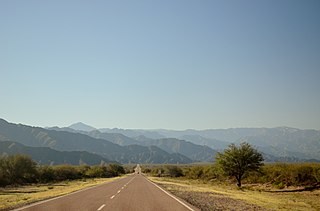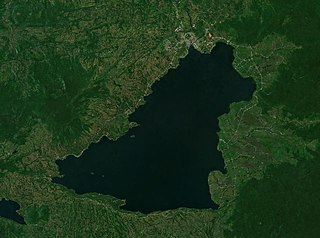
The family Chinchillidae is in the order Rodentia and consists of the chinchillas, the viscachas, and their fossil relatives. This family is restricted to southern and western South America, mostly living in mountainous regions of the Andes but one species living on plains. They are medium to large-sized rodents, weighing from 800 g (28 oz) to 8 kg (18 lb), with strong hind legs and large ears and a bushy tail. All species have thick, soft fur, which is considered valuable in some cultures.

Viscachas or vizcachas are rodents of two genera in the family Chinchillidae. They are native to South America and look similar, but are not closely related, to rabbits. The viscacha looks much like a rabbit due to convergent evolution.

Catamarca is a province of Argentina, located in the northwest of the country. The province had a population of 334,568 as per the 2001 census [INDEC], and covers an area of 102,602 km2. Its literacy rate is 95.5%. Neighbouring provinces are : Salta, Tucumán, Santiago del Estero, Córdoba, and La Rioja. To the west it borders the country of Chile.

La Rioja is a province of Argentina located in the west of the country. The landscape of the province consist of a series of arid to semi-arid mountain ranges and agricultural valleys in between. It is in one of these valleys that the capital of the province, the city of la La Rioja, lies. Neighboring provinces are from the north clockwise Catamarca, Córdoba, San Luis and San Juan. The dinosaur Riojasaurus is named after the province.

San Martín is a department and region in northern Peru. Most of the department is located in the upper part of the Peruvian Amazon rainforest. Its capital is Moyobamba and the largest city in the department is Tarapoto.

Lake Lanao is a large ancient lake in the Philippines, located in Lanao del Sur province in the country's southern island of Mindanao. With a surface area of 340 km2 (130 sq mi), it is the largest lake in Mindanao, and the second largest lake in the Philippines and counted as one of the 15 ancient lakes in the world. Scholars have been pushing for the lake's inclusion in the UNESCO World Heritage List.

The Cape Floristic Region is a floristic region located near the southern tip of South Africa. It is the only floristic region of the Cape Floristic Kingdom, and includes only one floristic province, known as the Cape Floristic Province.

Chilecito is a city in the Argentine province of La Rioja, and head of the department of Chilecito.

Famatina is a town in the province of La Rioja, Argentina. It has 6,371 inhabitants as per the 2001 census [INDEC], and is the only municipality in the Famatina Department. Located in fertile valley between Sierra de Famatina and Sierra de Velasco Famatina's economy revolve around jojoba and olive agriculture and tourism.

The northern viscacha is a species of viscacha, a rodent in the family Chinchillidae. It is known from Peru and Chile, at elevations from 300 to 5000 m, and may also be present in Bolivia.

Lagidium is a genus of rodents in the family Chinchillidae. It contains these species:

The southern viscacha is a species of viscacha, a rodent in the family Chinchillidae found in Argentina, Bolivia, Chile, and Peru. It is a colonial animal living in small groups in rocky mountain areas. It has long ears and hind legs and resembles a rabbit in appearance apart from its long, bushy tail, but is not a lagomorph.

Luis Beder Herrera is an Argentine Justicialist Party (PJ) politician. He was the governor of La Rioja Province from 2007 to 2015.

La Rioja is an autonomous community and province in Spain, in the north of the Iberian Peninsula. Its capital is Logroño. Other cities and towns in the province include Calahorra, Arnedo, Alfaro, Haro, Santo Domingo de la Calzada, and Nájera. It has an estimated population of 315,675 inhabitants, making it the least populated region of Spain.
The Capayanes were an indigenous people, now extinct, that lived in Argentine territory.

Villa Unión is a city in northwestern Argentina and the main settlement of Departamento Coronel Felipe Varela with a population of 12,263.

The Sierras Pampeanas is a geographical region of Argentina.

Lagidium ahuacaense is a rodent in the mountain viscacha genus (Lagidium) that occurs in southern Ecuador. First observed in 2005 and formally described in 2009, it occurs more than 500 km (310 mi) north of the nearest previously known population of mountain viscachas in central Peru. Only a single population is known, found on rocky habitats on Cerro El Ahuaca, an isolated granite mountain in southern Ecuador, and as few as several dozen individuals remain. The species is threatened by fires and grazing cattle, and the discoverers recommended its conservation status be assessed as critically endangered.

Sierra de Famatina is mountain range and massif in the Andes of the Argentine province of La Rioja. The range rises between the north-south valleys of Bermejo and Antinaco-Los Colorados. The highest point, designated Cerro General Belgrano, rises 20,505 ft and is featured in the coat of arms of La Rioja Province.

Villa Castelli is a small town and seat of the General Lamadrid Department in the Province of La Rioja, northwestern Argentina. As of 2010 it had a population of 1,697.


















